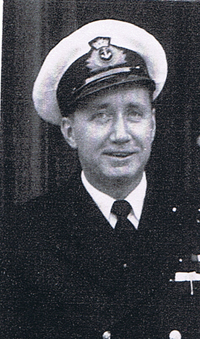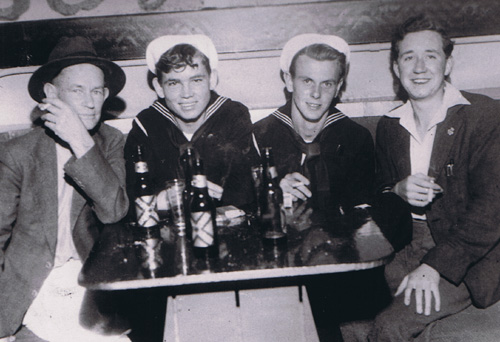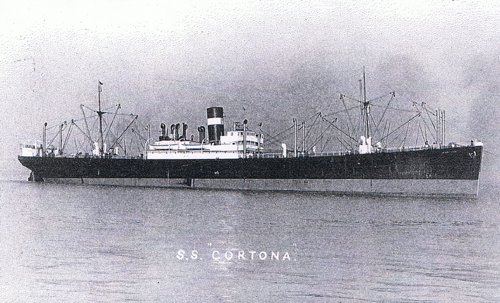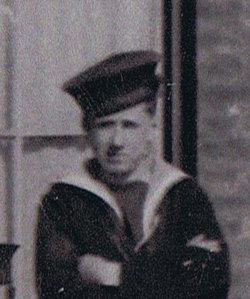Captain John Garnet Smith
/back
 Born in the Midland town of Walsall April
1926. One of four children an older sister Betty and younger sister Cynthia and
brother Maurice. There is an early photo of John taken in October 1941 when he
was 15 a day before he joined the Prince of Wales Sea Training School at Ingham
Hall. He is seated at a table displaying the wooden model warships he had made
out of scraps of wood. Captain Scott's ship the Discovery took pride of place in
the centre. At home he recorded in a book the name and silhouette of any British
war ship that had been announced lost. His father had served in the Royal Navy
during the first world war and an uncle was now serving in the same service.
There seemed no link with the Merchant Navy.
Born in the Midland town of Walsall April
1926. One of four children an older sister Betty and younger sister Cynthia and
brother Maurice. There is an early photo of John taken in October 1941 when he
was 15 a day before he joined the Prince of Wales Sea Training School at Ingham
Hall. He is seated at a table displaying the wooden model warships he had made
out of scraps of wood. Captain Scott's ship the Discovery took pride of place in
the centre. At home he recorded in a book the name and silhouette of any British
war ship that had been announced lost. His father had served in the Royal Navy
during the first world war and an uncle was now serving in the same service.
There seemed no link with the Merchant Navy.
Prior to joining up when the air raid siren sounded he would be off on his bike
to the local ARP station acting as a messenger. Since leaving North Walsall
school at the age of fourteen he had been employed in the De Havilland aircraft
factory at Aidridge in the frame making section. We do not know what inspired
John to join the Merchant Service. It could have been he answered an advert that
appeared in the news papers at the time. They were looking for younger recruits
than the Royal Navy to serve as Merchant seamen.
John attended the British Sailor Society Sea Training School at Ingham Hall
Norfolk. 20th October 1941 and left 2 June 1942. Others remembered attending at the
time were, Taffy Vaughan, Lofty Burns, Tom Brennand and
Bob Ball who after all these years remains a firm family friend of the Smith
family.
A month after leaving the school Johns first ship the Donaldson line “Cortona”
7093 was torpedoed in the Atlantic while outward bound Liverpool to Buenos
Aires by two U-boats U 20l Albert Schnee and U.116 Werner Von Schmidt on 11th
July 1942. After spending 10 days in a life boat with 23 survivors and sailing
300 miles hoping to make landfall in the Canary Isles they were picked up by HMS
Pathfinder and landed in Londonderry. The other boat that got away with 29 crew
members under the command of the chief mate was lost. U 201 under the command of
Gunther Rosenberg was attacked and sunk with all hands by HMS Viscount on
February 17th 1943. U 116 commanded by Willhelm Grirnme sailed on the 22nd of
September 1942 and disappeared without trace.
John torpedoed on his first trip at 16 years
of age served on Merchant ships throughout the war without any further mishaps.
He made seafaring his career and befriended by a Chief Officer was encourage to
study for his third mates ticket and continued on to gain his Masters ticket at
the age of 36. Serving all of his time with the Caltex and Texaco Oil Company.
As Master of the super tankers Texaco Greenwich, London, Great Britain and Spain
to name a few. He visited Auckland New Zealand on the Caltex Columbo with his
wife Maisie where they met up with his sister and brother and on another
occasion called into Marsden point refinery while on the Texaco Greenwich. His
other sister Cynthia was able to see him when the same ship visited Los Angeles.
He was paid off in 1981 as a senior Master when the Company was reformed and the
ships came under new management. He retired to live in Eastbourne. Seafaring was
John's only career and the forced early retirement came as a shock, being shore
bound he found it hard to adjust to the stationary lifestyle. He died 31st Dec
1993
John's sister Betty used to write to another member of the Ingham Hall at the
time Tom Brennand from Blackburn. He joined his first ship “MV Stentor” Alfred
Holt Line. When returning from West Africa to Britain with palm oil, and 125
passenger and 121 crew it was torpedoed by U 509 Werner Witte on 27 Oct 1942
near the Canary Islands. Boats were lowered and the ship abandoned. HMS Woodruff
picked up 201 survivors the other 45 crew members and passengers lost their
lives including Tom Brennand just four months after he left Ingham Hall. He was
an only child. Betty visited the family to offer her condolences.
U 539 was attacked by air and sunk with all hands Julyl5th 1943 off Madeira.
I would like to offer my thanks and appreciation to Andy the Director of the PWSTS for giving all the old boys, their families and siblings the opportunity
to be remembered and have their stories told.
Maurice Smith

San Francisco 7th July 1943 - John Smith far
right aged 17 yrs

A War Time Story - The First Trippers
On a clear crisp morning on 20th October 1941, in the city of Norwich, three
young lads met at a bus terminal for the first time.
 They were John Smith from Walsall Staffordshire, Tom Brennand from Blackburn
Lancashire and Bob Ball from Bexhill-on-Sea Sussex. They discovered that they
were each waiting to catch the same bus that would take them to the village of
Ingham. There they would receive first class training, second to none in
preparation for war time service on deck in the Merchant Navy. They were all
keen for the opportunity to be able to serve their country in its time of need.
They bonded together straight away and formed a friendship that continued
throughout their training period and for John and Bob a lasting friendship that
would continue throughout both war and post war years for both themselves and
their respective families. On the completion of their intensive training, the
three lads left the school together in 1942 and each joined the very different
ships assigned to them.
They were John Smith from Walsall Staffordshire, Tom Brennand from Blackburn
Lancashire and Bob Ball from Bexhill-on-Sea Sussex. They discovered that they
were each waiting to catch the same bus that would take them to the village of
Ingham. There they would receive first class training, second to none in
preparation for war time service on deck in the Merchant Navy. They were all
keen for the opportunity to be able to serve their country in its time of need.
They bonded together straight away and formed a friendship that continued
throughout their training period and for John and Bob a lasting friendship that
would continue throughout both war and post war years for both themselves and
their respective families. On the completion of their intensive training, the
three lads left the school together in 1942 and each joined the very different
ships assigned to them.
Tom Brennand signed on the Blue Funnel Line M.V Stentor a passenger cargo
vessel. His ship was torpedoed on the 27th October 1942, off the Canary Islands
by U Boat 509, Kapitan-Leutnant Witte. From a compliment of 246, only 201
survivors were picked up by HMS Woodruff. Tragically amongst the 45 who lost
their lives was young Tom Brennand, aged fifteen and a half years old. He had
only left the PWSTS a few months earlier. He was an only child. U Boat 509 was
subsequently attacked by aircraft on 15th July 1943 off Madeira. She was sunk
losing all hands.
John Smith signed on the Donaldson Line M.V Cortona, a general cargo ship of
7093 grt, and when outward bound from Liverpool to Buenos-Aires was torpedoed in
the Atlantic in August 1942 by two U Boats U201, Kapitan Schnee and U116,
Kapitan Werner von Schmidt. John spent ten days in a life boat with twenty three
other survivors. They attempted to land fall in the Canary Islands but were
picked up by HMS Pathfinder and landed in Londonderry. The second life boat
launched, commanded by the first mate and twenty nine crew members were never
found.
John being a fit young man, easily shook off this war time experience but what
he did find hard to accept on being paid off at the end of that unfortunate
episode was the discovery that it was general practice of all shipping companies
to stop crew members wages at exactly the time their ships were sunk beneath
them, together with all their possessions, for which they received no
compensation. How very different were American Seamen treated by contrast when
the USA entered the war. Each and every man was insured by their government for
$10,000. Their wages were twice that of our own on top of which they received
bonuses for every theatre of war in which they sailed, 100% for North & South
Atlantic & Mediterranean, 80% for the Pacific and Indian Oceans and 40% for
sailing anywhere else.
John Smith carried on with his war time service without any further mishaps and
decided to make seafaring his career and with the help of friendly bridge
officers he studied and passed his Third-Second and First mates examinations. He
finally obtained his Masters Certificate while serving with Caltex & Texaco Oil
Company during which time he took command of the Texaco Greenwich – London –
Britain – and Spain to name but a few. He retired with his wife Maisie to
Eastbourne in 1981 with the rank of Senior Company Master.
Bob Ball signed on the Union Castle Line Capetown Castle 27,000 grt a 26 knot
troop ship which owing to her fast turn of speed sailed unescorted out of
convoy. His first trip as such was almost uneventful by comparison with that of
Tom and John’s experience and he served on a wide variety of ships there after
mostly on Atlantic crossing in convoy. He later took part in the D Day Normandy
landings initially getting Canadian troops from the Lake Superior Regiment and
their equipment successfully onto their beach head. Then shortly after was
engaged in shipping supplies and equipment to our forces engaged in the push up
Italy on the Adriatic Coast and then with a crossing to Dubrovnic and Split with
supplies and weapons for Tito’s Yugoslavian Chetniks. Bob carried on seafaring
after the wars end for a further two years before leaving the sea to join the
family construction business and later taking up post in Nigeria and the West
Indies. He gained a degree in Civil Engineering and finally retired in 1993 with
his wife Ilse in Bexhill-On-Sea.
The number of merchant ships lost during the last war totalled five thousand one
hundred and fifty. Three thousand of which were sunk by U Boats and fifty
thousand merchant seamen from the United Kingdom, Commonwealth counties, Canada
and the USA lost their lives in the service of their countries. By comparison
Germany’s U Boat service lost thirty five thousand men from a total number of
forty thousand.
It was very unfortunate that in 1975 the Prince of Wales training school was
obliged to cease functioning, probably caused by the lack of requested from
shipping companies for fully trained boys wishing to take up a career at sea.
This is mainly due to the shrinking size of our post war merchant fleets and the
practice of shipping companies generally registering their ships under various
flags of convenience in order to cut costs. Plus the practise of engaging
untrained and cheaper crews from various parts of the world who were prepared to
work under lower standards and conditions than those enjoyed on ships flying the
Red Duster.
Bob Ball
 Born in the Midland town of Walsall April
1926. One of four children an older sister Betty and younger sister Cynthia and
brother Maurice. There is an early photo of John taken in October 1941 when he
was 15 a day before he joined the Prince of Wales Sea Training School at Ingham
Hall. He is seated at a table displaying the wooden model warships he had made
out of scraps of wood. Captain Scott's ship the Discovery took pride of place in
the centre. At home he recorded in a book the name and silhouette of any British
war ship that had been announced lost. His father had served in the Royal Navy
during the first world war and an uncle was now serving in the same service.
There seemed no link with the Merchant Navy.
Born in the Midland town of Walsall April
1926. One of four children an older sister Betty and younger sister Cynthia and
brother Maurice. There is an early photo of John taken in October 1941 when he
was 15 a day before he joined the Prince of Wales Sea Training School at Ingham
Hall. He is seated at a table displaying the wooden model warships he had made
out of scraps of wood. Captain Scott's ship the Discovery took pride of place in
the centre. At home he recorded in a book the name and silhouette of any British
war ship that had been announced lost. His father had served in the Royal Navy
during the first world war and an uncle was now serving in the same service.
There seemed no link with the Merchant Navy.

 They were John Smith from Walsall Staffordshire, Tom Brennand from Blackburn
Lancashire and Bob Ball from Bexhill-on-Sea Sussex. They discovered that they
were each waiting to catch the same bus that would take them to the village of
Ingham. There they would receive first class training, second to none in
preparation for war time service on deck in the Merchant Navy. They were all
keen for the opportunity to be able to serve their country in its time of need.
They bonded together straight away and formed a friendship that continued
throughout their training period and for John and Bob a lasting friendship that
would continue throughout both war and post war years for both themselves and
their respective families. On the completion of their intensive training, the
three lads left the school together in 1942 and each joined the very different
ships assigned to them.
They were John Smith from Walsall Staffordshire, Tom Brennand from Blackburn
Lancashire and Bob Ball from Bexhill-on-Sea Sussex. They discovered that they
were each waiting to catch the same bus that would take them to the village of
Ingham. There they would receive first class training, second to none in
preparation for war time service on deck in the Merchant Navy. They were all
keen for the opportunity to be able to serve their country in its time of need.
They bonded together straight away and formed a friendship that continued
throughout their training period and for John and Bob a lasting friendship that
would continue throughout both war and post war years for both themselves and
their respective families. On the completion of their intensive training, the
three lads left the school together in 1942 and each joined the very different
ships assigned to them.